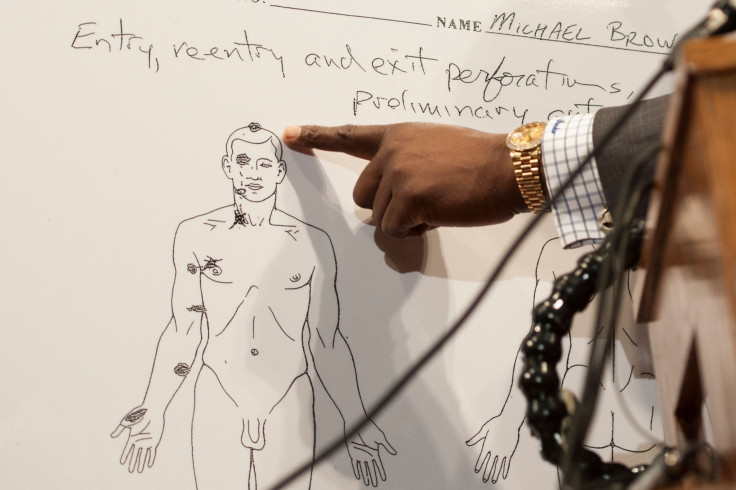Ferguson Grand Jury Evidence: Brown University Students Decode Jargon So Regular People Can Understand Medical Documents

Since Thanksgiving, nine Brown University students have spent more than 80 hours poring over medical evidence presented to the grand jury in the Michael Brown case. They revealed their masterpiece on Monday: The Ferguson Decoded project, a website that turns legal jargon into layman's terms. Ferguson Decoded features dumbed-down versions of Brown's autopsy report, Officer Darren Wilson's physical examination and DNA analysis with colored text, images and plain English to rehash the findings in easy-to-digest "translations."
Rian Yalamanchili, the 25-year-old editor-in-chief of the project, said that in order for the prosecutors to achieve true transparency, the American public must be able to understand the evidence on which the St. Louis County grand jury based its contentious decision. As it stood, though, comprehending the documents was "very, very difficult without a working knowledge of anatomy," he said.
Plus, "even though expert witnesses had been called to testify during the hearing, it is important to remember that this testimony would only represent a few perspectives, including that of the medical examiner who already works closely with prosecutors," according to the website.
That's where the students, all enrolled at Brown's Warren Alpert Medical School, decided they could help. They composed straightforward summaries of the evidence, taking descriptions like "no swelling, deformity or crepitus, mild ecohymosis developing to area, no palpable pain to bilateral TMJ and full ROM to TMJ" and rewriting them as "no swelling, abnormality, or crackling/popping noises of the jaw bones. Mild bruising. No pain at the jaw joint. Fully able to move jaw," according to a Brown press release.
They added notes to clarify what they were writing, too. When Wilson's physical mentions the potentially scary-sounding "Naprosyn," the authors explain that it's just Aleve. When the autopsy brings up fluid in one of Brown's kidneys, they note that it's probably unrelated to his injuries.
"There are so many conflicting stories, so I hope the autopsy information can contribute to piecing together the information," 23-year-old second-year medical student Hyunwoo "June" Choo wrote in an email.
Once the Brown students finished their run-through of the documents, they had Brown faculty in forensics, pathology and health care review the content to ensure its accuracy. Yalamanchili said they also tried to present the facts in a fair, impartial manner.
"We felt that it was important to remain as objective and neutral as possible during this project because of how extremely divisive this topic has been nationally," he wrote in an email. "We did this to ensure that our 'translations' can eliminate as much personal bias as possible, for we want this project to reach out to as many people as possible, regardless of what their stance may be on the decision."
Yalamanchili, who will graduate in 2017, said he hopes other students see the Ferguson Decoded project and help out with further translations of other documents. His team will keep focusing on Ferguson -- "our plates are already pretty full during medical school," he said.
Choo would also like to see the project expand. But for now, she's satisfied with the carefully nonpolitical position Ferguson Decoded takes. "I think it makes a greater statement to future high-profile investigative processes -- especially those with high temptation of bias -- that there will be informed public who will take a second or third look at the released documents," she said.
Brown, a black unarmed 18-year-old, was fatally shot by white police officer Wilson on Aug. 9. A grand jury decided last month not to charge Wilson for his actions. The police killing and subsequent grand jury decision sparked protests across the nation.
© Copyright IBTimes 2024. All rights reserved.






















